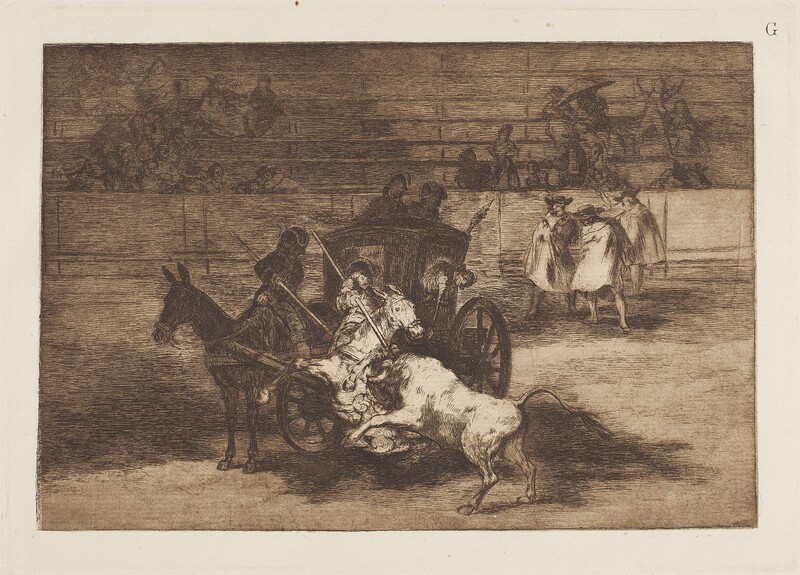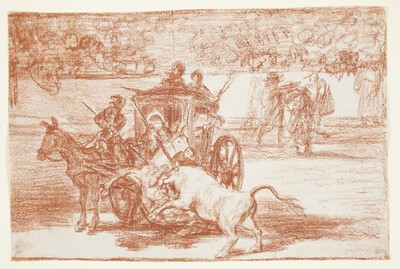- Cronología
- 1814 - 1815
- Dimensiones
- 253 x 349 mm
- Técnica y soporte
- Aguafuerte, aguatinta, punta seca, buril y bruñidor
- Reconocimiento de la autoría de Goya
- Documented work
- Ficha: realización/revisión
- 02 Oct 2021 / 22 Jun 2023
- Inventario
- -
- Otros títulos:
-
G (print, upper right-hand corner)
See How the ancient Spaniards hunted bulls on horseback in the countryside
The print, rejected by Goya and not included in the first edition of the Bullfighting of 1816, was added and published for the first time, along with six other (A-G), in the third edition of the series, published by Eugène Loizelet in Pais in 1876. It was retained in subsequent editions of the Bullfighting .
A state proof is preserved before the letter was inscribed.
The plate of the print is preserved in the National Chalcography (no. 373), with The male value of the famous Pajuelera in Zaragoza engraved on the obverse.
See How the ancient Spaniards hunted bulls on horseback in the countryside
This engraving depicts a very curious scene: a horse-drawn carriage in the middle of the bullring, which serves as a complement to the bullfighting. Several men, dressed in the fashion of the late 18th century, are riding in the carriage, attempting to spear a bull who is in turn attacking a picador on horseback next to the carriage, who also thrusts his pike at the bull with viciousness, as is evident from the expression on his face, which can be seen perfectly as this is the part of the plate that receives the most light. This circumstance also allows us to see that the bull has stuck the picador's horse with a pitón and that blood is dripping down, an unusual occurrence in the series. In the background of the scene are three figures wearing capes and hats. The composition is delimited by the barrier and the seats in the stands, which are occupied by a variety of people, although the seats are not crowded.
According to Lafuente Ferrari, thanks to an original bullfighting poster still preserved, it has been posible to determine that a bullfight like this one, probably the one that inspired the print, took place in the Aranjuez bullring on 17 June 1797.
There is a preparatory drawing for this print, also entitled Combat of a harnessed carriage with two mules (Bullfighting G)
-
Grabados y dibujos de Goya en la Biblioteca NacionalBiblioteca NacionalMadrid1946catalogue Elena Páez Ríos
-
Goya en la Biblioteca Nacional. Exposición de grabados y dibujos en el sesquicentenario de su muerteBiblioteca NacionalMadrid1978May - June 1978
-
Grabados de Goya: colección propiedad de la Biblioteca Nacional, que se conserva en su Gabinete deCasa de la Amistad de MoscúMoscow1979exhibition displayed from January 18th to 31st 1979
-
1984
-
Madrid1987
-
Madrid1990
-
Goya grabadorFundación Juan MarchMadrid1994consultant editors Alfonso E. Pérez Sánchez and Julián Gállego, from January 14th to March 20th 1994
-
Goya grabadorMuseo del Grabado Español ContemporáneoMarbella1996from March 8th to May 5th 1996
-
Ydioma universal: Goya en la Biblioteca NacionalBiblioteca NacionalMadrid1996from September 19th to December 15th 1996cat. 280
-
Schlaf der Vernunft. Original radierungen von Francisco de GoyaMunich2000
-
Madrid2002
-
Madrid2002
-
Bilbao2012
-
Zaragoza2017
-
1946pp. 177-216, espec. pp. 185 y 213
-
BarcelonaTartessos-F. Oliver Branchfelt1946 (reed. 1951)
-
OxfordBruno Cassirer1964vol. II, 1964, p. 357, cat. 243
-
Vie et ouvre de Francisco de GoyaParísOffice du livre1970p. 280, cat. 1231
-
Goya, toros y torerosMadridMinisterio de Cultura, Comunidad de Madrid1990p. 124, cat. 59
-
Catálogo de las estampas de Goya en la Biblioteca NacionalMadridMinisterio de Educación y Cultura, Biblioteca Nacional1996cat. 368
-
Ydioma universal: Goya en la Biblioteca NacionalMadridBiblioteca Nacional, Sociedad Estatal Goya 96 y Lunwerg1996p. 250
-
MadridMuseo Nacional del Prado2001pp. 106-107
-
Goya. In the Norton Simon MuseumPasadenaNorton Simon Museum2016pp. 186-201

